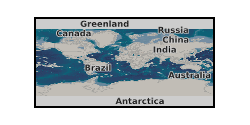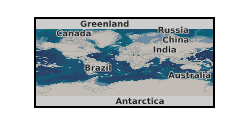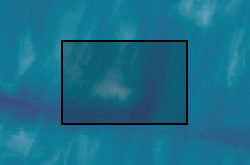University of Southampton, National Oceanography Centre Southampton
Type of resources
Topics
Keywords
Contact for the resource
Provided by
Years
Formats
Representation types
Update frequencies
Resolution
-

CO2 was injected into shallow unconsolidated marine sediments in Ardmucknish Bay, Oban. 2D seismic reflection data were collected pre-release (15/05/2012), syn-release (17/05/2012, 18/05/2012, 19/052012, 29/05/2012, 30/05/2012, 20/06/2012) and after release stages (23/04/2014 and 24/04/2014) of CO2 help to better understand the spatial and temporal evolution of free gas anomalies within the overburden. The impact of CO2 on sediment acoustic properties, namely seismic reflectivity and attenuation, was also investigated. This dataset was collected by the National Oceanography Centre Southampton (NOCS) and the British Geological Survey (BGS) under the program QICS (Quantifying and monitoring environmental impacts of geological carbon storage) which was funded by the Natural Environment Research Council (NERC), with support from the Scottish Government. The dataset includes segy files, a presentation which summarises the main results and a map showing the spatial extent of the seismic data collected after gas release. QICS project website: http://www.bgs.ac.uk/qics/home.html. Cevatoglu et al., 2015. Gas migration pathways, controlling mechanisms and changes in sediment acoustic properties observed in a controlled sub-seabed CO2 release experiment. Int J Greenhouse Gas Control. DOI:10.1016/j.ijggc.2015.03.005. NERC grant NE/H013873/1
-

CO2 was injected into shallow unconsolidated marine sediments in Ardmucknish Bay, Oban. 2D seismic reflection data were collected pre-release (15/05/2012), syn-release (17/05/2012, 18/05/2012, 19/052012, 29/05/2012, 30/05/2012, 20/06/2012) and after release stages (23/04/2014 and 24/04/2014) of CO2 help to better understand the spatial and temporal evolution of free gas anomalies within the overburden. The impact of CO2 on sediment acoustic properties, namely seismic reflectivity and attenuation, was also investigated. This dataset was collected by the National Oceanography Centre Southampton (NOCS) and the British Geological Survey (BGS) under the program QICS (Quantifying and monitoring environmental impacts of geological carbon storage) which was funded by the Natural Environment Research Council (NERC), with support from the Scottish Government. The dataset includes segy files, a presentation which summarises the main results and a map showing the spatial extent of the seismic data collected after gas release. QICS project website: http://www.bgs.ac.uk/qics/home.html. Cevatoglu et al., 2015. Gas migration pathways, controlling mechanisms and changes in sediment acoustic properties observed in a controlled sub-seabed CO2 release experiment. Int J Greenhouse Gas Control. DOI:10.1016/j.ijggc.2015.03.005. The post-release data is currently restricted. NERC grant NE/H013873/1
-

Carbon capture and storage (CCS) is a key technology to potentially mitigate global warming by reducing carbon dioxide (CO2) emissions from industrial facilities and power generation that escape into the atmosphere. To broaden the usage of geological storage as a viable climate mitigation option, it is vital to understand CO2 behaviour after its injection within a storage reservoir, including its potential migration through overlying sediments, as well as biogeochemical and ecological impacts in the event of leakage. The impacts of a CO2 release were investigated by a controlled release experiment that injected CO2 at a known flux into shallow, under-consolidated marine sediments for 37 days. Repeated high-resolution 2D seismic reflection surveying, both pre-release and syn-release, allows the detection of CO2-related anomalies, including: seismic chimneys; enhanced reflectors within the subsurface; and bubbles within the water column. In addition, reflection coefficient and seismic attenuation values calculated for each repeat survey, allow the impact of CO2 flux on sediment acoustic properties to be comparatively monitored throughout the gas release. CO2 migration is interpreted as being predominantly controlled by sediment stratigraphy in the early stages of the experiment. However, either the increasing flow rate, or the total injected volume become the dominant factors determining CO2 migration later in the experiment. This is a publication in QICS Special Issue - International Journal of Greenhouse Gas Control, Peter Taylor et. al. Doi:10.1016/j.ijggc.2015.03.005.
-

Whilst sub-seabed Carbon Capture and Storage (CCS) has the potential to remove a significant proportion of anthropogenic CO2 emissions at source, research is necessary to constrain the environmental impacts of potential future gas leaks from storage reservoirs. The QICS project (Quantifying and Monitoring Potential Ecosystem Impacts of Geological Carbons Storage) was established to improve our understanding of these potential impacts and to develop tools and best practice for monitoring sub-seabed CCS reservoirs. Exposure to increased environmental CO2 has been shown to raise the tissue pCO2 of many marine invertebrate species, leading to tissue acidosis and perturbations in both ion transport and bicarbonate buffering. These disturbances can cause downstream effects, seen as metabolic depression in susceptible organisms, compromising the role of particular species within an ecosystem and even causing the local extinction of species groups. To monitor the potential impact to surficial benthic megafauna, cages of bivalves (the common mussel Mytilus edulis Linnaeus, 1758 and the king scallop Pecten maximus (Linnaeus, 1758)) were deployed at the gas release site and at a reference site—both within Ardmucknish Bay, Oban, Scotland. Replicate individuals were sampled at six time points over a 125-day period, which spanned both the 37-day injection and recovery phases of the experiment, in order to establish impacts to molecular physiology. Samples of bivalves were also simultaneously sampled from a reference site within the bay in order to contrast changes in physiology induced by the gas release with naturally variability in the physiological performance of both species. We present data on changes in the transcription of genes coding for key ionic and carbon dioxide regulatory proteins. There was no evidence of gene regulation of either selected carbonic anhydrases (CAx genes) or the alpha subunit of sodium potassium ATPAses (ATP1A genes) in individual bivalves collected from the CO2 gas release site, in either species. In the common mussel M. edulis there was only evidence for changes with time in the expression of genes coding for different classes of carbonic anhydrase. It was therefore concluded that the effects of the plume of elevated pCO2 on ion-regulatory gene transcription were negligible in both species. Whilst the analysed data from this current study do not constitute an impediment to the continued development of sub-seabed CCS as a climate mitigation strategy, further modelling is necessary to predict the consequences of larger or longer term leaks. Further analysis is also required in order to constrain the potential physiological impacts of gas leaks to benthic infaunal species and understand the mechanism of possible avoidance behaviour recorded in burrowing heart urchins Echinocardium cordatum (Pennant, 1777). This is a publication in QICS Special Issue - International Journal of Greenhouse Gas Control, Nicola Pratt et. al. Doi:10.1016/j.ijggc.2014.10.001.
-

Physical properties of four serpentinite and four gabbro samples acquired respectively at the Southern Wall (IODP leg 357) and at the Central Dome (IODP leg 304-305) of the Atlantis Massif have been measured and analysed in the frame of a NERC UK-IODP moratorium research. The physical property measurements included simultaneous ultra-sonic wave velocities (compressional and shear wave velocities), attenuation, electrical resistivity and permeability under increasing and decreasing effective pressure ranging between 5 and 45 Mpa. Measurements were carried out using the experimental physical property measurement rig of the rock Physics laboratory of the National Oceanography Centre, Southampton, UK. The porosity and the density of the samples were estimated using their wet dry weight difference and the volume of the samples, under atmospheric pressure and room temperature. The aim of this research project was to learn about the physical properties of oceanic lower crustal and upper-mantle rocks and to find a geophysical method that would allow to distinguish between these rocks, remotely. The dataset has been acquired and interpreted by a science party including researchers from the University of Southampton and the National Oceanography Centre. The ultrasonic wave velocities, attenuation and the electrical resistivity for each sample and for each effective pressure (increasing from 5 to 45 with an interval of 10 MPa and decreasing from 45 to 5 with an interval of 20 MPa) are reported in this dataset. Permeability measurements could have been carried out only on 6 samples for which the permeability was high enough to be measured with the experimental rig.
-

This dataset includes the (stable) oxygen and carbon isotopic composition of benthic foraminifer tests (n= 686) and the (radiogenic) isotopic composition of the terrigenous fraction of marine sediments (n= 75), all sampled from Eocene to Oligocene-aged sediments recovered at Ocean Drilling Program (ODP) Site 689 and 690 (Maud Rise, Southern Ocean)
 NERC Data Catalogue Service
NERC Data Catalogue Service